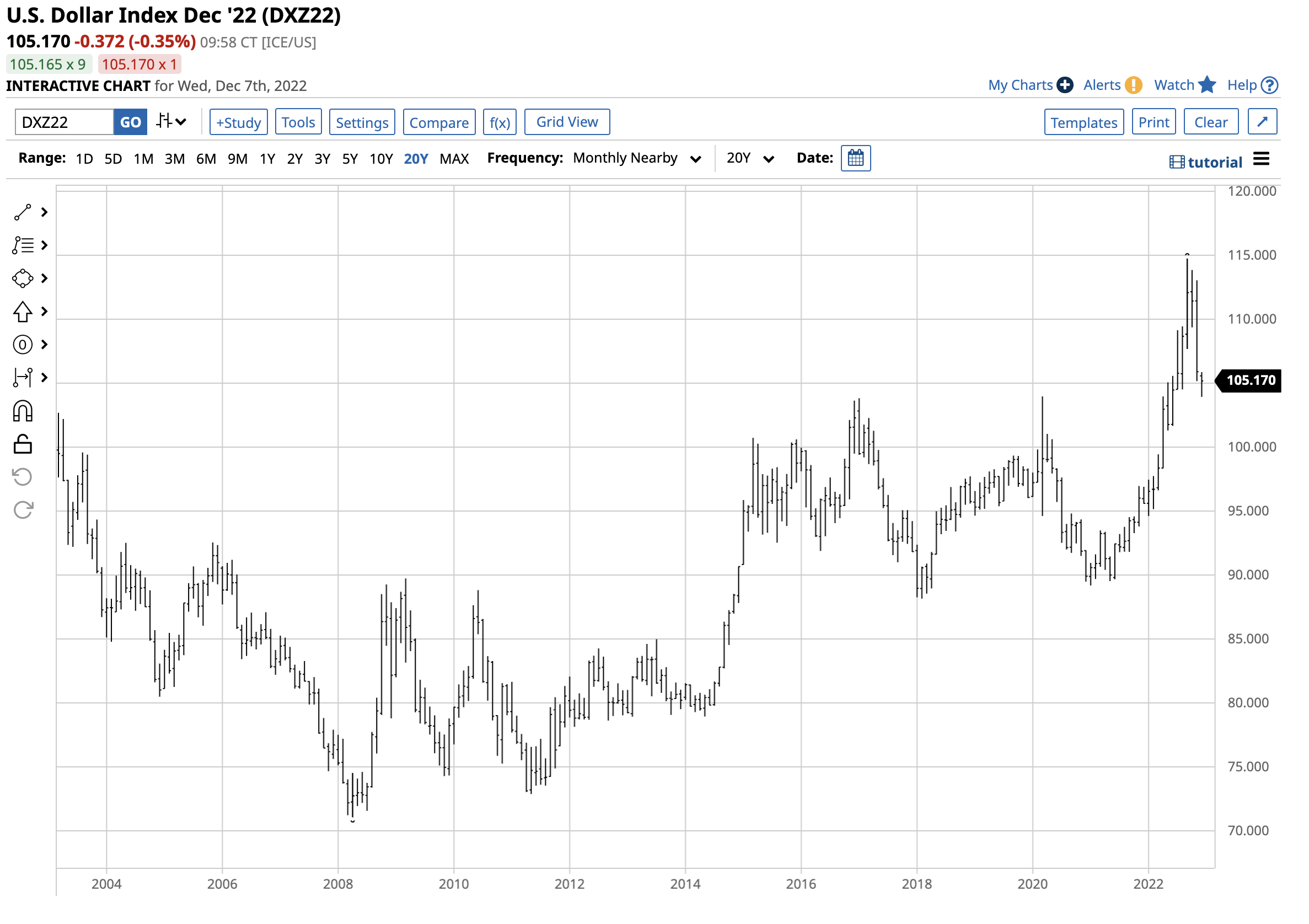
The dollar index is a benchmark that measures the U.S. currency against other world reserve currencies. The euro accounts for the index’s most significant exposure, with a 57.6% weighting. The euro traded below parity against the U.S. dollar, a two-decade low, but it has moved back above over the past weeks.
The U.S. dollar is critical as it is the benchmark pricing mechanism for most commodities. A strong dollar tends to weigh on commodity prices, and when its value declines, it often supports higher raw material prices. Moreover, a strong dollar makes U.S. multinational companies less competitive against other international firms, weighing on U.S. corporate profits.
The Invesco DB U.S. Dollar Index Bearish Fund (UDN) moved higher as the dollar index fell, and its bullish counterpart (UUP) rallied when the index moved higher.
Resistance became support
In March 2020, the nearby dollar index futures contract reached a high of 103.960, where it ran out of bullish steam, and fell to a low of 89.165 in January 2021. The March 2020 became technical resistance for the leading precious metal.

The chart highlights the move above the 103.96 resistance level in May 2022, which took the index that measures the U.S. currency against other world reserve currencies to the highest level since 2002 at 114.745 in September 2022. The resistance at 103.96 became technical support after the index broke out and followed through on the upside.
Over the past weeks, the dollar index has been moving lower and tested the support with the level at just over 105 on December 7. The December dollar index traded to a low of 103.935 on December 2, probing below the support level.
The Fed holds the key to the path of least resistance
Interest rate differentials play a significant role in the value of one currency versus another. Since March 2022, the U.S. Federal Reserve has increased short-term interest rates at the most aggressive pace in decades. The short-term Fed Funds Rate rose from zero to 25-basis points in March 2022 to 3.75% to 4.00% as of December 7. The market expects another 50-basis point increase at the upcoming December FOMC meeting.
Meanwhile, quantitative tightening, or reducing the Fed’s swollen balance sheet, is pushing interest rates higher for longer maturities. The bottom line is that the U.S. central bank’s monetary policy path has supported the dollar’s move to a two-decade high in 2022.
Currency trends last for years as governments manipulate values for stability
The latest bullish trend in the dollar began in January 2021 when the index reached its 89.165 low. Since then, the dollar index has made higher lows and higher highs that took it to 114.745 in late September.

The chart shows the short-term bullish trend in the dollar index. The move to below the 103.96 level on December 2 threatens the bullish trend, and the next technical support sits at the May 30 101.30 low.
Meanwhile, the long-term trend, dating back to 2008, remains bullish.

The twenty-year chart illustrates the dollar index’s path of higher lows and higher highs since the 2008 71.05 low. The long-term technical support remains far below the current level at 89.165.
Currency trends can last for years as governments intervene in the foreign exchange markets. The intervention reflects the need for stability for cross-border payments, causing central banks, monetary authorities, and governments to buy and sell foreign exchange instruments to prevent price spikes that could impact and upset the global financial system.
The geopolitical landscape is a significant factor in late 2022
The bifurcation on the geopolitical landscape caused by China’s “no-limits” alliance with Russia impacts the foreign exchange arena. With Russia and China on one side and the US and Europe on the other, the potential for currency volatility has increased. The U.S. dollar had traditionally been the currency of choice during tumultuous times on the geopolitical landscape, but China, the world’s second-leading economy, could be avoiding the dollar in support of Russia. After Russia invaded Ukraine, sanctions and retaliation caused the Russians to establish a link between its ruble and gold, declaring that 5,000 rubles were exchangeable for one gram of gold. If China follows Russia and avoids the dollar, it will limit the dollar’s role as the world’s reserve currency.
Russia invaded Ukraine because it considers the country part of western Russia, while the U.S. and NATO members in Europe believe Ukraine is a sovereign Eastern European country. In Asia, China considers Taiwan a breakaway republic that belongs under Beijing’s control. The U.S., Japan, and Europe support Taiwanese independence. The geopolitical landscape remains divided, which could upset the status quo of currency markets, diminishing the dollar’s leadership role. Increased volatility in the foreign exchange arena could be on the horizon in the current environment.
The UDN has moved higher as the dollar index declined
The Invesco DB U.S. Dollar Index Bearish Fund (UDN) rallies when the dollar index falls, and the bullish Fund (UUP) rallies when the dollar index moves to the upside. The highlights of the UDN and UUP are:
- At $18.32 per share on December 7, UDN had $74.877 million in assets under management. The ETF trades an average of 318,229 shares daily and charges a 0.77% management fee.
- At $28.41 per share on December 7, UUP had $2.150 billion in assets under management. UUP trades an average of over 4.27 million shares daily and charges a 0.78% management fee.
The December dollar index fell from 114.745 on September 28 to a low of 103.935 on December 2, a 9.42% decline.

Over the same period, UDN rose from $16.75 to $18.45 per share or 10.15%, as UDN did an excellent job tracking the dollar index on the downside. The UUP product tends to do the same on the upside. However, UDN and UUP only trade during hours when the U.S. stock market operates. Since the foreign currency markets trade around the clock, UDN and UUP could miss highs or lows during the Asian or European time zones.
The dollar index is at a critical level on December 7 as it tested its technical support at just below the 104 level. However, the long-term trend over the past fourteen years remains bullish. Rising U.S. interest rates as the Fed continues to battle inflation support the U.S. currency, while the geopolitical landscape could cause lots of price variance over the coming months.
More Forex News from Barchart
- Stocks Under Pressure as Weak Chinese Trade News Sparks Global Growth Concerns
- Markets Today: Stocks Mixed On Negative Chinese Trade News
- Dollar Gains as Stocks Slump
- Stocks Moderately Lower on Weakness in Technology Stocks





/Alphabet%20Inc_%20and%20Google%20logos%20by%20IgorGolovinov%20via%20Shutterstock.jpg)

/Stickers%20with%20AMD%20Radeon%20and%20Nvidia%20GeForce%20RTX%20graphics%20on%20new%20laptop%20computer%20by%20Piotr%20Swat%20via%20Shutterstock.jpg)
/Robinhood%20app%20on%20phone%20by%20Andrew%20Neel%20via%20Unsplash.jpg)